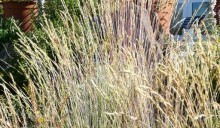Festuca varia
(Festuca varia)

Description
Festuca (fescue) is a genus of flowering plants belonging to the grass family Poaceae (subfamily Pooideae). They are evergreen or herbaceous perennial tufted grasses with a height range of 10–200 cm (4–79 in) and a cosmopolitan distribution, occurring on every continent except Antarctica.The genus is closely related to ryegrass (Lolium), and recent evidence from phylogenetic studies using DNA sequencing of plant mitochondrial DNA shows that the genus lacks monophyly. As a result, plant taxonomists have moved several species, including the forage grasses tall fescue and meadow fescue, from the genus Festuca into the genus Lolium, or alternatively into the segregate genus Schedonorus. Fescue pollen is a significant contributor to hay fever. Festuca grasses are perennial and bisexual plants that are densely to loosely cespitose. Some grasses are rhizomatous, some lack rhizomes, and rarely species are stoloniferous. The culms of the grasses are typically glabrous and smooth, though some species have scabrous culms or culms that are pubescent below the inflorescences. The leaf sheaths range from open to the base to closed to the top. Some species have sheaths that persist over years and typically have deciduous blades, and some species have sheaths that quickly shred into fibers and decay in senescence and typically have blades that are not deciduous. Species lack auricles. The membranous ligules measure 0.1–8 mm (0.0039–0.3150 in) and are typically longest at the margins. The ligules are typically truncate and ciliate, though they can occasionally be acute or erose. The flat and conduplicate leaf blades are involute or convolute and are sometimes glaucous or pruinose. The abaxial surfaces of leaf blades are glabrous or scabrous and occasionally pubescent or puberulent. The adaxial surfaces of leaf blades are typically scabrous, though occasionally are hirsute or puberulent. The abaxial sclerenchyma tissue forms longitudinal strands that vary in presence from the margins and opposite of the midvein to adjacent to some or every lateral vein. These longitudinal strands occasionally merge into interrupted or continuous bands. Bands of confluent strands that reach veins are known as "pillars". The adaxial sclerenchyma tissue sometimes forms strands that are opposite or extend to epidermal veins. Some strands form "girders" together with the abaxial sclerenchyma tissue that connect epidermides at some or all veins.
Taxonomic tree:







